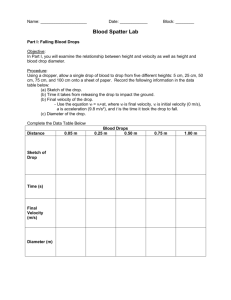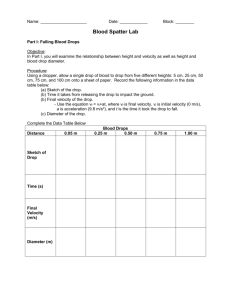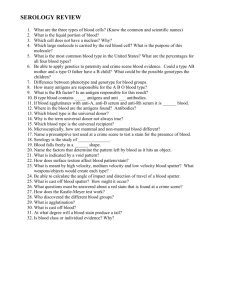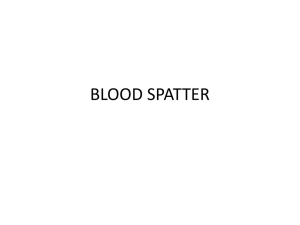Blood Spatter Lab
advertisement
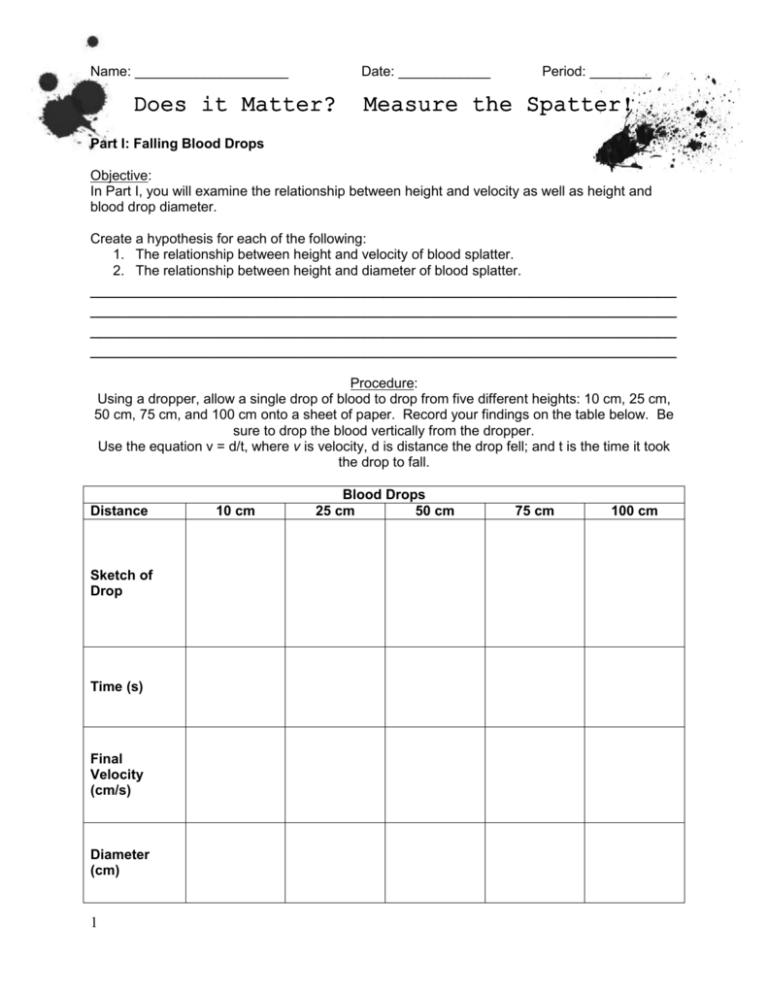
Name: ____________________ Date: ____________ Does it Matter? Period: ________ Measure the Spatter! Part I: Falling Blood Drops Objective: In Part I, you will examine the relationship between height and velocity as well as height and blood drop diameter. Create a hypothesis for each of the following: 1. The relationship between height and velocity of blood splatter. 2. The relationship between height and diameter of blood splatter. ____________________________________________________________ ____________________________________________________________ ____________________________________________________________ ____________________________________________________________ Procedure: Using a dropper, allow a single drop of blood to drop from five different heights: 10 cm, 25 cm, 50 cm, 75 cm, and 100 cm onto a sheet of paper. Record your findings on the table below. Be sure to drop the blood vertically from the dropper. Use the equation v = d/t, where v is velocity, d is distance the drop fell; and t is the time it took the drop to fall. Distance Sketch of Drop Time (s) Final Velocity (cm/s) Diameter (cm) 1 10 cm Blood Drops 25 cm 50 cm 75 cm 100 cm Procedure: Predict what the blood spatter would look like from 1.25 meters (150 cm) and at 2 meters (300 cm). Draw what you think each blood drop will look like on the table below. Be sure to take the size of the drop into consideration. Blood Drops 1.25 m 2m Now that you have predicted what blood spatter will look like from 1.25 meters and 2 meters, drop the blood from both of those heights. How did the actual blood spatter compare with your prediction? Explain in 1-2 sentences. 2 Part II: Impact Angles Objective: In Part II, you will be determine the relationship between angle size and shape of blood spatter. Create a hypothesis regarding the relationship between angle of impact and shape of blood splatter: ____________________________________________________________ ____________________________________________________________ ____________________________________________________________ Procedure: Using a protractor and a dropper, allow a single drop of blood to drop from three ACUTE angles: 45°, and two others of your choice onto a sheet of paper. Record your data and answer the questions below. Draw a picture of each blood drop in the table below. Drop Angles ° 45° 3 ° Follow-Up Questions: 1. Were you able to distinguish differences in shape between the 10 cm and 25 cm drop? Explain any differences. 2. Using your data complete the following graphs: a. Velocity vs. Distance b. Diameter vs. Distance 3. Examine your Velocity vs. Distance graph. What is the relationship between the final velocity and the distance the blood drop fell? 4. Using your graph, determine the final velocity of a blood drop if it fell 65 centimeters. 5. Examine your Diameter vs. Distance graph. What is the relationship between diameter of the blood drop and the distance the blood drop fell? 6. In terms of velocity, why did the drops (in comparison to each other) look the way they did? 7. Determine the relationship between the angle of impact and the shape of the blood drop. 8. What are some things done during this lab that could account for inconsistencies in the data? 4 Name: ____________________ Date: ____________ Period: ________ Blood Spatter Lab Part III: Blood Spatter Objective: In Part III, you will use observations and calculations to determine how drop shape can be used to determine a blood drop’s velocity and impact angle. 1. Figure 1 shows blood spatter at low and high velocity from 10 cm and 20 cm. Indicate which spatter from each height was low velocity or high velocity. (2 points) 10 cm A B 20 cm C D 2. How were you able to distinguish between high and low velocity? (1 point) 3. Figure 2 shows blood drops from different heights: 1 cm, 10 cm, 30 cm, 40 cm, 50 cm, 75 cm, and 100 cm. Rank the blood drops in order from lowest to highest. (3 points) 1 cm - _________ 10 cm - _________ 50 cm - _________ 30 cm - _________ 75 cm - _________ 40 cm - _________ 100 cm - _________ 4. In terms of velocity and drop shape, how were you able to determine the drop height order? (1 point) Velocity: Drop Shape: 5. Figures 3 and 4 show blood spatter at different angles. Calculate the angles for each using the equation: sin c = width / length. Show your work in the space below. (6 points) A B C D E F Calculations Angles 5 6
